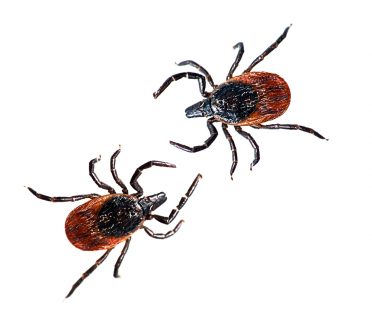This page contains affiliate links. We may earn money or products from the companies mentioned in this post through our independently chosen links, which earn us a commission. Learn More
Lyme disease is a bacterial illness that is transmitted by some species of ticks, also known as Lyme borreliosis. The case of Lyme disease in dogs or other animals is that they don’t show signs of infections in 2 to 5 months. Lyme disease in dogs leads to damage in kidneys, heart, and nervous system.
If you suspect your pet is suffering from Lyme disease, don’t panic. We’ll tell you all about this disease and its symptoms and effects so you’ll have the information you need before bringing your pet to the vet.
Contents & Quick Navigation
What is Lyme disease in dogs?

Deer ticks
Discovered in Lyme, Connecticut, this illness is also called Borreliosis.
It’s caused by the bite of a deer tick, which transfers Borrelia burgdorferi bacteria to the dog’s bloodstream and causes infection.
The insect can latch onto your dog’s skin while your pet is playing in tall grass, thick brush, or in the woods.
The infection usually occurs after the tick has been attached to your dog for at least 48 hours.
A lot of people think that all ticks cause the disease, but not all of these insects are carriers of the Borrelia bacteria. Depending on where you live, the disease may be spread by deer ticks (mid-Atlantic, northeastern, north-central US) or the western blacklegged tick (Pacific coast).
What are the symptoms of this disease?
Unlike humans, the disease can be a little tricky in dogs since they don’t show that telltale bull’s-eye rash that humans do.
The first symptoms you’ll see in your dog are usually lethargy, fever, and stiffness or lameness in one or more limbs. You may also notice that his lymph nodes and joints are inflamed.
Here’s a video that discusses some signs that your dog is infected with Lyme disease.
In its advanced stages, the infection will cause issues with your pet’s nervous system, heart complications, and liver damage.
The key to bringing your pooch back to health is taking him to the vet as soon as you suspect that he’s suffering from the disease. The longer that the infection or the disease is left untreated, the more problems it will cause for your dog’s health.
Can the infection be transmitted to humans?
Lyme disease in dogs is rarely contagious to humans. You’ll get the disease from your pet only if the infected tick that has been feeding on your furry buddy latches on to you, as well.
You can avoid this by always checking your dog’s coat if you’ve been playing in potentially tick-infested areas.
If you find ticks attached to your dog, avoid directly touching them. Use gloves and tweezers (or other dog tick removal tools) to detach them from the coat. Make sure you get the whole specimen, especially the head, and place the tick in a jar of rubbing alcohol to kill it.
You can also get your dog some vet-recommended tick control products like collars and topical medication to repel these insects and kill any present on the coat.

How does this disease affect dogs?
The effects depend on your dog’s immune system and how severe the infection is. In some cases, the symptoms don’t manifest until a few weeks after the bacteria infects the dog.
There are three states or levels of Lyme disease:
- Acute – At this stage, you’d see common symptoms such as depression, pain, fatigue, and the other general signs of illness we mentioned earlier. Aside from lameness, the swollen joints may feel warm to the touch.
- Subacute – This is where you’d see persistent lameness in your pet, as opposed to the shifting lameness of the earlier state. Your dog may also experience transient or persistent arthritis.
- Chronic – At this state, the disease can have effects on your pet’s cardiac and neurological systems. Your vet may discover arrhythmia and kidney damage as well.
You may see the signs of any of the three states in your dog. Sometimes, you can see symptoms that indicate the subacute state, then the disease may progress to the next level within a few days.
Golden Retrievers and Labrador Retrievers may also be predisposed to Lyme nephritis, which can occur due to the kidney damage caused by the disease.
Signs of Lyme nephritis include vomiting, weight loss, muscle wasting, stinky breath, and edema or excess fluid. This condition is usually fatal, so if you suspect your Golden or Lab has Lyme disease, make sure you take him to the vet as soon as you can.
The infection can also be more dangerous for pregnant dogs, as treatment can cause miscarriage. Certain tick control products are not recommended for expecting mothers, too, so you’ll want to take extra caution in protecting her from the disease.
How is Lyme disease in dogs diagnosed?

A Husky getting a physical exam from a vet
Diagnosing this disease can be challenging as the vet would have to rule out other conditions.
Symptoms of the disease can be similar to some signs of orthopedic conditions or even cancer.
The vet will have to take into consideration the history of your dog’s health, his recent activities, and the signs that first manifested in your pet.
Your canine buddy will also undergo a thorough physical examination, especially if he’s showing signs of stiffness or lameness.
An x-ray will help the vet determine if your dog has spine or joint injuries or other abnormalities that can be causing the symptoms.
Once all other possible conditions are ruled out, the vet will test for Lyme disease using the C6 or Snap 4Dx test and the Quantitative C6 test.
The Snap 4Dx detects antibodies against a protein that can be found only in Borrelia bacteria. These antibodies may be present in your dog’s bloodstream even before he shows any signs of illness.
If antibodies are found in your dog’s blood, the Quantitative C6 test will be performed. This test determines if antibody levels are high enough to require treatment.
Treating canine Lyme disease
Antibiotics are commonly prescribed to treat this disease. Usually, your dog can complete his or her treatment at home. You can expect an improvement in his health within 3 to 5 days.
Sometimes, it would be a 2 to 4-week course, depending on the severity of the disease. If you notice that your dog’s symptoms are getting worse after a week, bring your pet back to the vet for another analysis.

If your pet is suffering from extreme pain and swelling in his joints, he will also need anti-inflammatory medication.
While your dog is undergoing treatment and recovery, make sure that he has a quiet and calm space where he can rest without being disturbed.
Since lameness and incoordination are symptoms of Lyme disease, make sure that your dog won’t need to use the stairs to move around.
Even if the treatment is going well, a follow-up appointment should be made to make sure that the medications are effective.
Keeping your dog safe from this disease
 One of the best ways to avoid this disease is to stay away from wooded areas, places with tall grass, or anywhere that can have an infestation of ticks.
One of the best ways to avoid this disease is to stay away from wooded areas, places with tall grass, or anywhere that can have an infestation of ticks.
Make it a routine to check your pet’s coat, particularly between his toes, in his ears, and in his armpits.
The good news is that there are a lot of collars, topical products, and sprays that you can use to keep ticks away from your dog.
You can ask your vet about a Lyme disease vaccine for your dog. It’s usually given twice at a 2 to 3-week interval, with an annual booster. The vaccine will not prevent your pet from getting this disease, but it lowers his risk of getting infected.
Keep an eye on your canine buddy and take into account all precautions to prevent your dog from getting this disease, or other illnesses from insects such as Leishmaniasis.
Is your dog a survivor of Lyme disease? Is he currently undergoing treatment? Tell us about your experience with this disease by leaving a comment below.

1 reply on “A Quick Guide on Lyme Disease in Dogs”
Still searching for answers, my female was diagnosed with lymes the day she deliver, she had 5 puppies within him 2 weeks all puppies died except 1, is this due to untreated disease while pregnant?